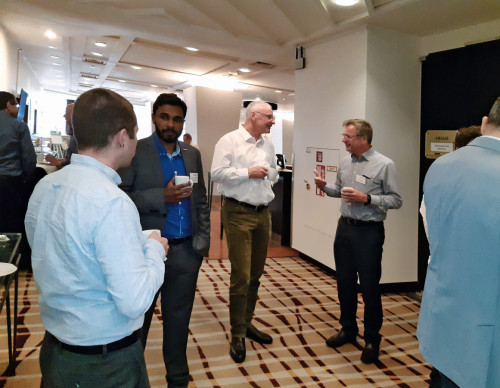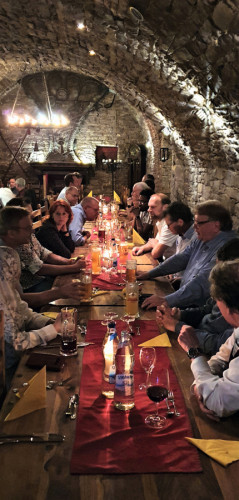Around 40 participants came together at the Achat Hotel Karlsruhe City to talk about tribological coatings for the first time since the pandemic on May 17-18, 2022. The event was organized by the European Research Association for Thin Films e.V.
Tribology deals with the scientific description of friction, wear and lubrication of coated or uncoated surfaces in relative motion to each other. The effects of tribological properties on technically usable systems and the possibilities for their optimization are key issues in this field of work. Tribology is a topic of increasing economic importance and is becoming more and more important in combination with the topics of sustainability and finite resources. A longer service life and functionality of systems through optimum wear protection of the components enables an extension of the service life of the systems and thus a reduction in the requirements for the production of the necessary materials, energy and labor. The increased product service life resulting from reduced wear also enables an increase in resource efficiency and thus makes a significant contribution to achieving social sustainability goals. The workshop provided an overview of current and planned research and development in the field of tribology in the context of sustainability. Some of the presentations are briefly presented below. If you are interested in individual contributions, please contact the EFDS(www.efds.org) or the speakers directly.
 The breaks provided space for contacts and discussions (Photo: Su)Dr. Matthias Woydt, Matrilub Berlin, began the lecture program with the "Importance of tribology for climate protection and sustainability" and backed up this statement with examples and figures. By reducing friction and ensuring a long service life, greenhouse gas emissions can be reduced during the utilization phase. Tribology and lubrication, both technology-based approaches to reducing carbon dioxide and greenhouse gases, contribute to this. In this way, friction reduction becomes a strategic planning tool for products and should be taken into account in emissions trading and the allocation ofCO2 certificates in the future.
The breaks provided space for contacts and discussions (Photo: Su)Dr. Matthias Woydt, Matrilub Berlin, began the lecture program with the "Importance of tribology for climate protection and sustainability" and backed up this statement with examples and figures. By reducing friction and ensuring a long service life, greenhouse gas emissions can be reduced during the utilization phase. Tribology and lubrication, both technology-based approaches to reducing carbon dioxide and greenhouse gases, contribute to this. In this way, friction reduction becomes a strategic planning tool for products and should be taken into account in emissions trading and the allocation ofCO2 certificates in the future.
"Tetrahedral amorphous carbon coatings and their diverse tribological properties" - In his presentation, Dr. Stefan Makowski, Fraunhofer Institute for Material and Beam Technology, Dresden, provided information on the properties and use of ta-C coatings for tribological applications. These coatings exhibit low friction and reduced wear, whereby the friction is strongly dependent on the ambient conditions (water, humidity, vacuum). A single-sided coating is often sufficient for optimum tribological behavior. New concepts also include vegetable oil lubrication, which promotes sustainability and environmental protection, and superlubrication, which is currently under development and can lead to extremely low friction values and therefore high energy savings.
In the article "Application-oriented evaluation of efficiency-enhancing carbon coatings on compression rings using a real stroke tribometer", Björn Michelberger, Steinbeis Transferzentrum WKKS GmbH, Friedrichshafen, was able to show that it is possible to transfer the measured values for solid-state friction from the real stroke tribometer to a single-cylinder test bench. This effect was demonstrated by the reduction of friction and wear through an a-C coating. It was also shown that topography and contour make a decisive contribution to fluid-dynamic interactions.
"High-performing solid lubricant films based on 2D materials - Sustainability and resource efficiency do matter in the 21st century" - Univ.-Prof. Dr.-Ing. Carsten Gachot, TU Vienna, presented an interesting new group of dry lubricants in his paper. Some of the so-called "MAX phases" (MXenes, 2D metal carbides, carbonitrides or nitrides of transition elements) show extraordinary wear resistance and are suitable for superlubrication. Their wide structural and chemical range enables a tailor-made layer/interface design to optimize tribological properties.
 Get Together at Badisch Brauhaus (Photo: EFDS)"Use of sensory tribological coatings in rolling contacts subject to mixed friction" - Stephan Emmrich, Otto von Guericke University Magdeburg, began by explaining the problem of mixed friction stress using gears as an example. Parameters such as pressure, temperature and lubrication gap height are crucial for the safe and efficient design of machine elements. Numerous tribological systems also constantly pass through the mixed friction area, which makes exact measurements difficult. Emmrich presented various thin-film sensor systems for measuring temperature (thermoresistive effect), pressure (conductor cross-section, piezoresistive effect) and lubrication gap height (capacitive distance measurement). The sensor materials used include chromium, platinum, titanium or nickel/chromium. The plan is to extend the existing temperature sensor for simultaneous measurement of temperature, pressure and lubrication gap height and to demonstrate the functionality of this sensor system for tooth flank and rolling element/raceway contact. Condition monitoring during operation should lead to an extension of maintenance intervals and a reduction in machine downtimes, resulting in greater sustainability.
Get Together at Badisch Brauhaus (Photo: EFDS)"Use of sensory tribological coatings in rolling contacts subject to mixed friction" - Stephan Emmrich, Otto von Guericke University Magdeburg, began by explaining the problem of mixed friction stress using gears as an example. Parameters such as pressure, temperature and lubrication gap height are crucial for the safe and efficient design of machine elements. Numerous tribological systems also constantly pass through the mixed friction area, which makes exact measurements difficult. Emmrich presented various thin-film sensor systems for measuring temperature (thermoresistive effect), pressure (conductor cross-section, piezoresistive effect) and lubrication gap height (capacitive distance measurement). The sensor materials used include chromium, platinum, titanium or nickel/chromium. The plan is to extend the existing temperature sensor for simultaneous measurement of temperature, pressure and lubrication gap height and to demonstrate the functionality of this sensor system for tooth flank and rolling element/raceway contact. Condition monitoring during operation should lead to an extension of maintenance intervals and a reduction in machine downtimes, resulting in greater sustainability.
In his presentation "Coatings for wind power applications", Dr. Serge Kursawe, Schaeffler Technologies AG & Co. KG, Herzogenaurach, was able to demonstrate the contribution that coatings from the Schaeffler Coating Toolbox can make to components in wind turbines. The range extends from main axle bearings (Trinodur C, Durotect B, Sensotect) to the bearing housing (Durotect B), the generator (Insultect A) and the blade pitch (Corrotect H, HP). The lecturer discussed the effect of the individual coatings using examples.
"Aspects of sustainability in tribological coatings - from deposition to application" - Dr. Bernhard Blug, Fraunhofer Institute for Mechanics of Materials IWM Freiburg, demonstrated in his presentation that improved system technology enables the deposition of very thin, dense coatings. Structuring also makes it possible to achieve lower coefficients of friction and, in some cases, considerably longer service lives. This results in a high energy-saving potential in various areas of application. Low-friction layers in soil cultivation, for example, can significantly reduce the emission of extremely highquantities of CO2. Hydrogen barrier layers in combination with tribological layers enable safe operation of the hydrogen economy, which is important for the energy transition. A high savings potential is also expected from alternative lubricants, through ultra-low friction up to super-lubrication.
The workshop was concluded by the presentation of the GfT Young Tribologists working group. Ms. Jennifer Eickworth, research associate at the Fraunhofer IWM and speaker at the TriboInnovation research platform, as well as current head of the Young Tribologists Working Group of the Gesellschaft für Tribologie e.V., provided information about the aims, organization and events of the working group. Its members would like to offer the younger generation a platform for the exchange of experience and knowledge in the field of tribology in a relaxed, friendly atmosphere.


